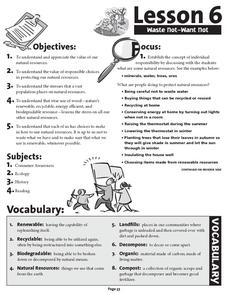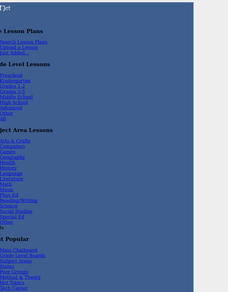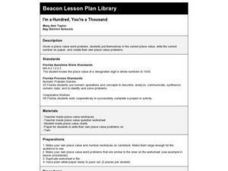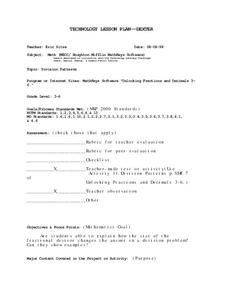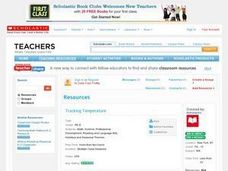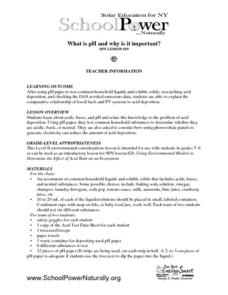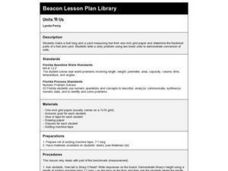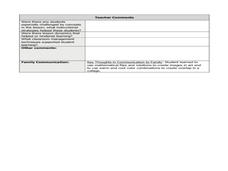Curated OER
Mixing Coins
Young scholars explore mixed (different denomination) coin sets and create different total amounts.
Curated OER
Animal Masks
Learners create wonderfully animate animal masks out of balloons. They use the papier-mache technique to create three dimensional animal masks taking care to consider color, shape, texture, and the animals' features.
Curated OER
Tissue Paper Geography
Learners explore geographic features of the desert and apply their understanding of the topography of the desert by creating a tissue paper painting.
Curated OER
Pizza Anyone?
Students, in groups, create models of pizzes and divide them, usin Unifix cubes, into fractions.
Curated OER
Waste Not Want Not
Young scholars are introduced to the need to save natural resources. Through inquiry, hands-on activities, and problem solving, students increase their understanding of solid waste materials and the need to reduce, recycle, and reuse.
Curated OER
Art of Japan - Textiles - Kimonos
Students examine and discuss the role of the Kimono in Japanese culture. They create Kimono Paper Weavings, Kimono Scratch Art, and Kimono Clay Sculptures.
Curated OER
Signs of Autumn
Second graders study photosynthesis and explore how chlorophyll is important to leaves and why leaves change colors in the fall.
Curated OER
Mesoamerican Codex Books
Fifth graders use visual art as a form of communication as they create a codex book based on their knowledge of Mesoamericans.
Curated OER
Farm Babies
Students use flash cards to match the mother names to the baby names for farm animals. In a designated "barn" in the room, students simulate being mothers, fathers, and babies. The baby must find his mother and father. Students visit...
Curated OER
A Waste Not Snowman
Students use everyday items to make a snowman. They collect items and bring them into school. They use glue to put the pieces together. They share their snowman with the class.
Curated OER
Creatures of the Sea
Fourth graders complete a two-month long unit on the physical characteristics of the oceans and animal environments. They create a "Creatures of the Sea" alphabet book in collaboration with a kindergarten class, conduct Internet...
Curated OER
Sonnets
Learners examine the structure of sonnets. They compare and contrast them with modern day poetry. They write their own sonnet after changing the language in another sonnet to see why the author choosed certain words.
Curated OER
I'm a Hundred, You're a Thousand
Second graders put themselves in the correct place value, write the correct number on paper, and create their own place value problems. The entire class plays a game using place value necklaces. This is a fun way to practice place value!
Curated OER
Division Patterns
Students investigate the concept of division and how numbers fit into specific patterns while practicing the skills finding equivalent fractions. They practice solving different division sentences while answering questions asked during...
Curated OER
Tracking Temperature
Students explore how to read a thermometer and what the instrument does. They practice measuring hot and cold objects and discuss changes in the weather based on temperature.
Curated OER
Identify Healthy Food and Lifestyle Choices
Poll your scholars about their choices on food they eat, or don't eat, and on maintaining a healthy lifestyle. Topic statements such as "I ate breakfast this morning" start a discussion on what are healthy choices and what are unhealthy...
Curated OER
Science Questions
Explore the concept of generating questions. Your curious learners choose a scientific question from a bowl and, as they listen to an article being read, they use that question starter to come up with their own questions. Then, they have...
Curated OER
Stamping Coins
Learners demonstrate that they can use a variety of coin combinations to make a single amount. They study all the ways to make 50 cents using coins using different coins.
Curated OER
What is pH and Why is It Important?
Students investigate about acids, bases, and pH and relate this information to the problem of acid deposition. They use pH paper, students test common household substances to determine whether they are acidic, basic, or neutral. Pupils...
Curated OER
Units 'R Us
Second graders, using one inch grid paper, create a foot long and a yard measuring tool.
Curated OER
Geometric Collages
Fourth graders investigate the concept of geometric patterning. They create their own patterns with a few basic requirements. The patterns must illustrate the concepts of flipping, 90 and 180 degree rotations. The collages also consist...
Curated OER
Bouncing Bubbles
Students complete a variety of activities exploring the joys and science of bubbles. They listen to the book "Bubbles Bubbles" by Mercer Mayer, create a bubble picture using Kid Pix, and explore blowing bubbles. Students experiment...
Curated OER
Air Pressure
Learners participate in a series of demonstrations about Bernoulli's principle. They explain how air pressure varies with air speed. They write a detailed lab report about the activity. This is a great way to explore this concept.
Curated OER
Using a Round-O-Meter to Estimate
Explore the concept of rounding numbers to the nearest dollar or dime. Youngsters use a "round-o-meter" to determine which direction to round a number. They make round-o-meters out of a piece of paper, a piece of string, and a paper clip.






